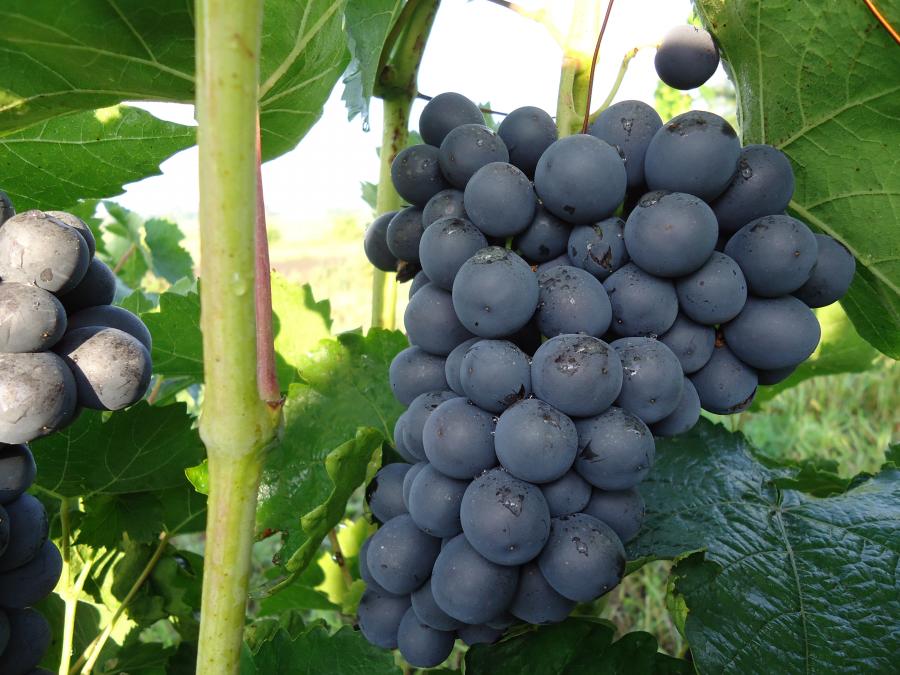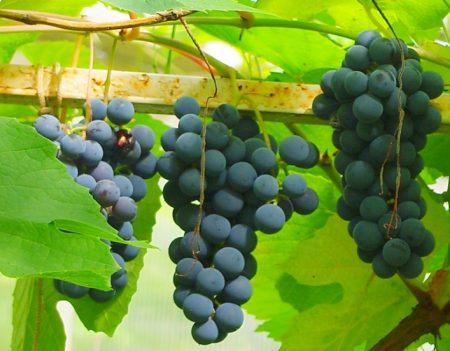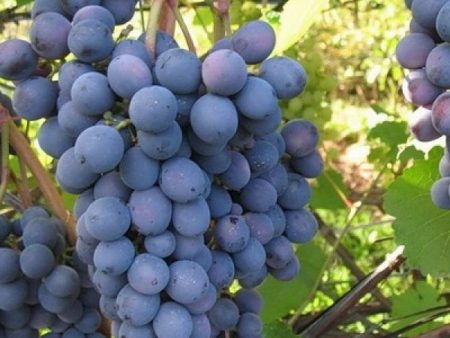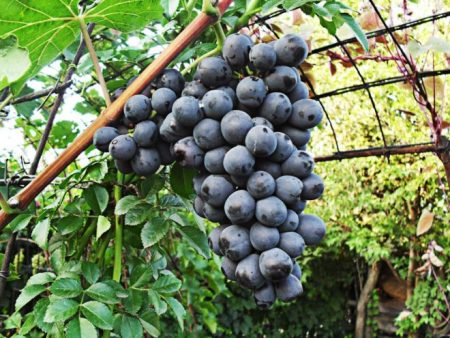 In some regions of the Russian Federation, growing grapes is quite problematic. But breeders simplified this task, thanks to their labors, varieties resistant to weather conditions appeared. One of the most popular is Chernysh grapes; it was bred at VNIIVV them. Potapenko. The variety appeared by crossing “Rusmol” and “Agate Donskoy” and is gaining popularity among the population every year.
In some regions of the Russian Federation, growing grapes is quite problematic. But breeders simplified this task, thanks to their labors, varieties resistant to weather conditions appeared. One of the most popular is Chernysh grapes; it was bred at VNIIVV them. Potapenko. The variety appeared by crossing “Rusmol” and “Agate Donskoy” and is gaining popularity among the population every year.
Variety Characteristics
 Chernysh belongs to table grape varieties. It is characterized by early ripening, clusters ripen approximately 116-125 days. Harvesting usually falls at the beginning of August, however, the timing depends on the region. The bushes are medium-sized, powerful, sprawling with a large number of shoots. "Chernysh" belongs to self-pollinated varieties, the flowers are bisexual, therefore, does not need pollinators to be planted. One or two brushes are formed on one shoot, the weight of one can be from 500 grams to a kilogram. Usually clusters are shapeless, sometimes cylindrical. Rounded berries, large from 22 to 26 mm, when ripe, turn blue with a light purple tint. The skin is dense, covered with a wax coating, the flesh is juicy, fleshy. Taste is high, berries contain up to 16% sugar, acids from 6 to 9 g per liter.
Chernysh belongs to table grape varieties. It is characterized by early ripening, clusters ripen approximately 116-125 days. Harvesting usually falls at the beginning of August, however, the timing depends on the region. The bushes are medium-sized, powerful, sprawling with a large number of shoots. "Chernysh" belongs to self-pollinated varieties, the flowers are bisexual, therefore, does not need pollinators to be planted. One or two brushes are formed on one shoot, the weight of one can be from 500 grams to a kilogram. Usually clusters are shapeless, sometimes cylindrical. Rounded berries, large from 22 to 26 mm, when ripe, turn blue with a light purple tint. The skin is dense, covered with a wax coating, the flesh is juicy, fleshy. Taste is high, berries contain up to 16% sugar, acids from 6 to 9 g per liter.
The variety is recommended for cultivation in the middle zone of the Russian Federation. The vine ripens quickly, tolerates frosts well up to -25 degrees Celsius. Productivity is high, with an adult bush you can collect up to 14 kg. Chernysh grapes can be eaten fresh, and it is also suitable for processing into juice and wine products. The variety is medium resistant to common diseases. It is characterized by increased resistance to diseases such as:
- mildew;
- oidium;
- gray rot;
The survival rate of cuttings is high, up to 99%. On the bush, 85% of fruiting shoots, the number of eyes from 38 to 43.
During the ripening period of berries, watering is stopped to prevent cracking.
Advantages
- high productivity;
- excellent immunity;
- attractive presentation;
- excellent taste of berries;
- long-term preservation of berries on a bush;
- frost resistance;
disadvantages
- with excess moisture, the berries crack, while the presentation of the product deteriorates;
- direct exposure to scorching sunlight can burn berries;
Growing
 It is better to plant grapes in the spring, after the threat of frost has passed. In autumn, planting cuttings is not recommended, as they may not have time to take root and die during the onset of cold weather. Only full seedlings will do. When planting several bushes, a distance of 150-200 cm is left between them. He digs holes of an average depth of about 60-70 cm. Some agronomists recommend preparing the landing pit in advance, especially if the soil is of poor quality. Crushed stone or broken brick is laid at the bottom, the next layer will be a mixture of soil with humus, there you can also add 20 g of superphosphate. After 14-21 days, the planting pit is dug up, a seedling is placed in it and covered with soil mixture. Then the soil is a little tamped and watered with warm, settled water (20-25 l).
It is better to plant grapes in the spring, after the threat of frost has passed. In autumn, planting cuttings is not recommended, as they may not have time to take root and die during the onset of cold weather. Only full seedlings will do. When planting several bushes, a distance of 150-200 cm is left between them. He digs holes of an average depth of about 60-70 cm. Some agronomists recommend preparing the landing pit in advance, especially if the soil is of poor quality. Crushed stone or broken brick is laid at the bottom, the next layer will be a mixture of soil with humus, there you can also add 20 g of superphosphate. After 14-21 days, the planting pit is dug up, a seedling is placed in it and covered with soil mixture. Then the soil is a little tamped and watered with warm, settled water (20-25 l).
The landing site is no less important, it should be sunny and protected from the cold wind. To protect a plant that has not yet matured, you can put a bucket without a bottom on top of it. For grapes, it is necessary to have a support on which it will trail.
Care
 For normal development and high productivity, the vine should be pruned. They do this in spring and autumn, remove excess branches and distribute the load on the bush. Typically, pruning is performed on 6-8 eyes. Despite the resistance to frost, the vine must be sheltered for the winter.To do this, it is removed from the support, sprinkled with a layer of soil, then sawdust or dry foliage, and then covered with a film.
For normal development and high productivity, the vine should be pruned. They do this in spring and autumn, remove excess branches and distribute the load on the bush. Typically, pruning is performed on 6-8 eyes. Despite the resistance to frost, the vine must be sheltered for the winter.To do this, it is removed from the support, sprinkled with a layer of soil, then sawdust or dry foliage, and then covered with a film.
Before the onset of cold weather, it is recommended to carry out water-charging irrigation.
Like any culture, grapes need watering, it is carried out 4-5 times per season, depending on weather conditions. For one adult plant, usually 40 to 60 liters of water are used. To prevent diseases, it is better to take preventive measures. Before flowering, grapes are treated with Bordeaux solution. As a top dressing, it is best to use solutions. And here is one of the popular recipes:
Ingredients:
- phosphoric fertilizers;
- nitrogen fertilizers;
- potash fertilizers;
- water;
Preparation and use:
In 10 liters of settled water at room temperature, 20 grams of the above fertilizers are added and mixed until completely dissolved. The grapes are watered with the resulting liquid under the root, 5-7 liters of solution will be sufficient for one plant.
Reviews
Lyubov Ivanovna
On my site grows more than 15 grape varieties and one of them is "Chernysh". They planted it 8 years ago, began to bear fruit in the second year, however, they harvested a little. It tastes great, I like it, it makes a very tasty juice. Resistance to diseases is high, during this time I have never been sick, I am saved from wasps by containers with sweetened water. The clusters are large, weighing up to a kilogram, ripen in early August.
Andrei
My brother is engaged in growing vineyards and making wine, and I'm just an amateur. Five years ago, he shared with me the cutlery "Chernysha." Planted it in the spring, the winter suffered just fine, but began to bear fruit only a year later. The berries are of high quality, but it is absolutely impossible to overfill them, otherwise they crack and scar. We eat grapes fresh and close the compote, the yield is excellent up to 12 kg.
"Chernysh" is an excellent high-yielding grape variety that is grown in the middle and southern strip of Russia. It is unpretentious in care, tolerates cold and has excellent immunity. The taste qualities of the berries are high, the variety is suitable for both fresh consumption and processing.




 Non-covering winter-hardy grape varieties for Moscow region
Non-covering winter-hardy grape varieties for Moscow region How to keep the vine in winter
How to keep the vine in winter When can I transfer grapes to another place in the fall
When can I transfer grapes to another place in the fall How to cover and prepare grapes for the winter in the suburbs
How to cover and prepare grapes for the winter in the suburbs